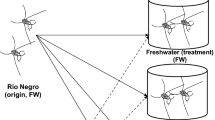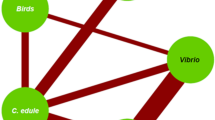Abstract
Relatively little is known about large-scale spatial and temporal fluctuations in bacterioplankton, especially within the bacterial families. In general, however, a number of abiotic factors (namely, nutrients and temperature) appear to influence distribution. Community dynamics within the Vibrionaceae are of particular interest to biologists because this family contains a number of important pathogenic, commensal, and mutualist species. Of special interest to this study is the mutualism between sepiolid squids and Vibrio fischeri and Vibrio logei, where host squids seed surrounding waters daily with their bacterial partners. This study seeks to examine the spatial and temporal distribution of the Vibrionaceae with respect to V. fischeri and V. logei in Hawaii, southeastern Australia, and southern France sampling sites. In particular, we examine how the presence of sepiolid squid hosts influences community population structure within the Vibrionaceae. We found that abiotic (temperature) and biotic (host distribution) factors both influence population dynamics. In Hawaii, three sites within squid host habitat contained communities of Vibrionaceae with higher proportions of V. fischeri. In Australia, V. fischeri numbers at host collection sites were greater than other populations; however, there were no spatial or temporal patterns seen at other sample sites. In France, host presence did not appear to influence Vibrio communities, although sampled populations were significantly greater in the winter than summer sampling periods. Results of this study demonstrate the importance of understanding how both abiotic and biotic factors interact to influence bacterial community structure within the Vibrionaceae.




Similar content being viewed by others
References
Amann, RI, Krumholz, L, Stahl, DA (1990) Fluorescent-oligonucleotide probing of whole cells for determinative, phylogenetic, and environmental studies in microbiology. J Bacteriol 172: 762–770
Amann, RI, Ludwig, W, Schleifer, KH (1995) Phylogenetic identification and in situ detection of individual microbial cells without cultivation. Microbiol Rev 59: 143–169
Amaro, C, Biosca, EG, Fouz, B, Alcaide, E, Esteve, C (1995) Evidence that water transmits Vibrio vulnificus biotype 2 infections to eels. Appl Environ Microbiol 61: 1133–1137
Anesio, AM, Abreu, PC, de Assis Esteves, F (1997) Influence of the hydrological cycle on the bacterioplankton of an impacted clear water Amazonian Lake. Microb Ecol 34: 66–73
Boettcher, KJ, Ruby, EG (1990) Depressed light emission by symbiotic Vibrio fischeri of the sepiolid squid Euprymna scolopes. J Bacteriol 172: 3701–3706
Cole, JR, Chai B, Marsh, TL, Farris, RJ, Wang, Q, Kulam, SA, Chandra, S, McGarrell, DM, Schmidt, TM, Garrity, GM, Tiedje, JM (2003) The Ribosomal Database Project (RDP-II): previewing a new autoaligner that allows regular updates and the new prokaryotic taxonomy. Nucleic Acids Res 31: 442–443
DeLong, EF (1992) Archaea in coastal marine environments. Proc Natl Acad Sci USA 89: 5685–5689
DeLong, EF (1997) Marine microbial diversity: the tip of the iceberg. Trends Biotechnol 15: 203–207
DeLong, EF (2001) Microbial seascapes revisited. Curr Opin Microbiol 4:290–295
DeLong, EF, Pace, NR (2001) Environmental diversity of bacteria and archaea. Syst Biol 50:470–478
DeLong, EF, Wu, KY, Prezelin, BB, Jovine, RV (1994) High abundance of Archaea in Antarctic marine picoplankton. Nature 371:695–697
DeLong, EF, Taylor, LT, Marsh, TL, Preston, CM (1999) Visualization and enumeration of marine planktonic archaea and bacteria by using polyribonucleotide probes and fluorescent in situ hybridization. Appl Environ Microbiol 65: 5554–5563
Glockner, FO, Amann, RI, Alfreider, A, Pernthaler, J, Psenner, R, Trebesius, K, Schleifer, KH (1996) An in situ hybridization protocol for detection and identification of planktonic bacteria. Syst Appl Microbiol 19: 403–406
Glockner, FO, Fuchs, BM, Amann, RI (1999) Bacterioplankton compositions of lakes and oceans: a first comparison based on fluorescence in situ hybridization. Appl Environ Microbiol 65: 3721–3726
Herndl, GJ, Reinthaler, T, Teira, E, van Aken, H, Veth, C, Pernthaler, A, Pernthaler, J (2005) Contribution of Archaea to total prokaryotic production in the deep Atlantic Ocean. Appl Environ Microbiol 71: 2303–2309
Hunter, CL, Stephenson, MD, Tjeerdema, RS, Crosby, DG, Ichikawa, GS, Goetzl, JD, Paulson, KS, Crane, DB, Martin, M, Newmans, JW (1995) Contaminants in oysters in Kaneohe Bay, Hawaii. Mar Poll Bull 30: 646–654
Jones, BW, Nishiguchi, MK (2004) Counterillumination in the Hawaiian Bobtail Squid, Euprymna scolopes Berry (Mollusca: Cephalopoda). Marine Biology 144: 1151–1155
Kaspar, CW, Tamplin, ML (1993) Effects of temperature and salinity on the survival of Vibrio vulnificus in seawater and shellfish. Appl Environ Microbiol 59: 2425–2429
Lee, K-H, Ruby, EG (1992) Detection of the light organ symbiont, Vibrio fischeri, in Hawaiian seawater by using lux gene probes. Appl Environ Microbiol 58: 942–947
Lee, K-H, Ruby, EG (1994) Effect of the squid host on the abundance and distribution of symbiotic Vibrio fischeri in nature. Appl Environ Microbiol 60: 1565–1571
Lee, K-H, Ruby, EG (1995) Symbiotic role of the viable but nonculturable state of Vibrio fischeri in Hawaiian coastal seawater. Appl Environ Microbiol 61: 278–283
Lindstrom, ES (2001) Investigating influential factors on bacterioplankton community composition: results from a field study of five mesotrophic lakes. Microb Ecol 42: 598–605
Maruyama, A, Sunamura, M (2000) Simultaneous direct counting of total and specific microbial cells in seawater, using a deep-sea microbe as target. Appl Environ Microbiol 66: 2211–2215
Massana, R, Pedros-Alio, C (1994) Role of anaerobic ciliates in planktonic food webs: abundance, feeding, and impact on bacteria in the field. Appl Environ Microbiol 60: 1325–1334
Morris, RM, Rappe, MS, Connon, SA, Vergin, KL, Siebold, WA, Carlson, CA, Giovannoni, SJ (2002) SAR11 clade dominates ocean surface bacterioplankton communities. Nature 420: 806–810
Motes, ML, DePaola, A, Cook, DW, Veazey, JE, Hunsucker, JC, Garthright, WE, Blodgett, RJ, Chirtel, SJ (1998) Influence of water temperature and salinity on Vibrio vulnificus in Northern Gulf and Atlantic Coast oysters (Crassostrea virginica). Appl Environ Microbiol 64: 1459–1465
Murray, RE, Hodson, RE (1985) Annual cycle of bacterial secondary production in five aquatic habitats of the Okefenokee swamp ecosystem. Appl Environ Microbiol 49: 650–655
Nishiguchi, MK (2000) Temperature affects species distribution in symbiotic populations of Vibrio spp. Appl Environ Microbiol 66: 3550–3555
Nishiguchi, MK, Nair, VS (2003) Evolution of symbiosis in the Vibrionaceae: a combined approach using molecules and physiology. Int J Syst Bacteriol 53: 2019–2026
Nishimura, M, Kogure, K, Kita-Tsukamoto, K, Ohwada, K (1995) Detection and direct count of specific bacteria in natural seawater using 16S rRNA oligonucleotide probe. Bull Jap Soc Microb Ecol 10: 109–113
Reinthaler, T, Winter, C, Herndl, GJ (2005) Relationship between bacterioplankton richness, respiration, and production in the Southern North Sea. Appl Environ Microbiol 71:2260–2266
Ruby, EG, Lee, K-H (1998) The Vibrio fischeri–Euprymna scolopes light organ association: current ecological paradigms. Appl Environ Microbiol 64: 805–812
Ruby, EG, McFall-Ngai, MJ (1992) A squid that glows in the night: development of an animal–bacterial mutualism. J Bacteriol 174: 4865–4870
Winter, C, Smit, A, Szoeke-Denes, T, Herndl, GJ, Weinbauer, MG (2005) Modelling viral impact on bacterioplankton in the North Sea using artificial neural networks. Environ Microbiol 7: 881–893
Acknowledgments
We are grateful to M. Sunamura and C. Miyako from the Maruyama Laboratory for advice with developing FISH probes. We also thank T. Henderson for help with FISH probe optimization. We would also like to thank the crew of the Neres and especially Laurent Zudaire for help with the CTD collection at the Laboratoire Arago. This work was supported by NSF DEB0316516, SBE0123690, and DBI007982, and NIH-SO6 GM08136-26 to M.K.N., and NIH-RISE GM61222-01 and NIH BRIDGES GM48998 for support of T. Henderson. B.W.J. was partially supported by an NSF Summer in Japan fellowship.
Author information
Authors and Affiliations
Corresponding author
Rights and permissions
About this article
Cite this article
Jones, B.W., Maruyama, A., Ouverney, C.C. et al. Spatial and Temporal Distribution of the Vibrionaceae in Coastal Waters of Hawaii, Australia, and France. Microb Ecol 54, 314–323 (2007). https://doi.org/10.1007/s00248-006-9204-z
Received:
Revised:
Accepted:
Published:
Issue Date:
DOI: https://doi.org/10.1007/s00248-006-9204-z




